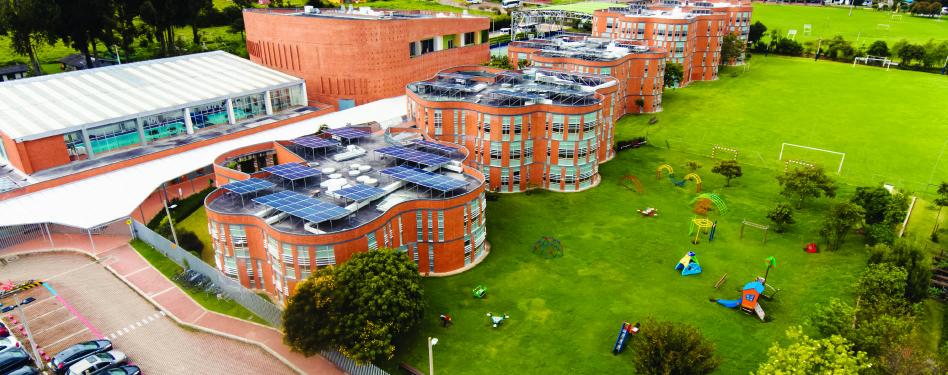
Feature image: The TRUE Gold Rochester School in Chía, Colombia. Image credit: Jorge Humberto Quintero Velez.
In 2023, the U.N. Environment Programme identified pollution as one of the five main drivers of the nature crisis. The TRUE program aims to protect global biodiversity through eco-conscious waste management practices that greatly mitigate the amount of pollution waste in circulation and existence. By changing the way materials flow through society, TRUE ensures that product materials are put to their best use, being reused and diverted from landfills, incineration and the environment.
TRUE collaborates with cities, businesses, schools, industrial sectors and others across the globe to help define, pursue and achieve zero waste goals while enhancing resource efficiency. The TRUE rating system requires a minimum of 90% waste diversion from landfill, incineration (waste-to-energy) and the environment, among other criteria, to guide projects toward waste reduction, resource efficiency and climate consciousness.
TRUE alignment with U.N. targets
By providing a rigorous framework and comprehensive resources, TRUE delineates and supports a clear path toward achieving the climate goals presented by the U.N., particularly the biodiversity objectives established in COP 15. TRUE inherently acknowledges the interconnectedness of human health, environmental health and economic prosperity in alignment with the U.N. biodiversity goals and aims to provide a structured approach that enables all organizations to reduce waste and optimize resource use effectively.
While TRUE aligns closely with the entirety of the COP 15 biodiversity framework, a few specific targets stand out as those that TRUE most directly helps achieve:
- Target 4: Halt Species Extinction, Protect Genetic Diversity and Manage Human-Wildlife Conflicts. TRUE’s waste management focus directly reduces pollution and other ecological hazards, protecting the natural environment. By eliminating waste through redesigning, reducing, reusing, composting (re-earthing), recycling and preventing hazardous waste, TRUE minimizes the amount of waste sent to landfills, incinerators and the environment—end points that result in costly impacts on biodiversity.
- Target 7: Reduce Pollution to Levels That Are not Harmful to Biodiversity. TRUE reduces pollution to levels that are not harmful to biodiversity by implementing comprehensive waste management strategies that address greenhouse gas emissions, waste pollution and hazardous chemicals.
- Target 16: Enable Sustainable Consumption Choices to Reduce Waste and Overconsumption. TRUE promotes sustainable consumption choices by emphasizing reducing, reusing and recycling, thereby addressing waste and overconsumption and maintaining environmental values when purchasing is necessary.
By the end of this century, 40% of all species on Earth could face extinction. This alarming statistic highlights the urgent need for action to preserve our planet’s biodiversity. One crucial approach is adopting zero waste practices. Reducing waste can eliminate environmental pollution, reduce the extraction of natural resources and mitigate the effects of climate change, protecting the future of both local and global biodiversity.
Zero waste and the promotion of biodiversity
One significant way zero waste practices contribute to biodiversity is by reducing the impact of landfills. Landfills, which often encroach on natural habitats, require large amounts of land. By reducing the amount of waste generated, zero waste programs decrease the need for landfills, thus protecting natural spaces.
Additionally, wasted food contributes 58% of all methane emissions from municipal solid-waste landfills. Methane is released when food waste decomposes in landfills before gas collection systems are in place. Rather than register unused food as food waste, TRUE opts for an edible food versus food scraps approach. This means food is repurposed into edible products for human consumption, and the remaining food scraps are used for animal feed or compost—ideally leaving no food to be sent to landfills.
The circular economy, a core principle of zero waste, supports biodiversity by promoting sustainable resource use and reducing the strain on natural environments. For instance, recycling cardboard takes only 75% of the energy required to produce new cardboard. The same cardboard can be recycled seven times, saving energy, oil and landfill space, thereby protecting ecosystems from further degradation.
TRUE's impact
Zero waste practices are essential for protecting biodiversity and ensuring the sustainability of our planet. By reducing waste, minimizing pollution and promoting a circular economy, zero waste initiatives directly contribute to the preservation of ecosystems and the species that inhabit them. Since 2017, TRUE-certified projects have diverted over 5.7 million tons of waste, illustrating the profound impact of zero waste on our environment.
The TRUE program has already made a significant impact worldwide, with 858 registered, precertified and certified projects spanning over 390 million square feet across 50 countries and 48 U.S. states. This demonstrates that TRUE is achievable at all levels and in diverse settings, as shown by projects local to COP 16, such as Rochester School in Chía, Colombia, which reached a remarkable 97.6% diversion rate, and Colgate-Palmolive, which has certified 30 manufacturing facilities in 18 countries across five continents.
If your organization is considering how to approach the Global Biodiversity Framework Targets, TRUE certification can be a powerful and practical tool to improve organizational efficiency and reduce harm to the planet.
